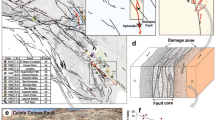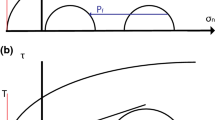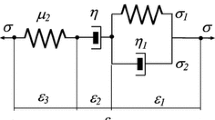Abstract
Coupling of rupture processes in solids with waves also propagating in fluids is a prominent phenomenon arising during tectonic earthquakes. It is executed here in a single ‘monolithic’ model which can asymptotically capture both damageable solids (rocks) and (visco-)elastic fluids (outer core or oceans). Both ruptures on pre-existing lithospheric faults and a birth of new faults in compact rocks are covered by this model, together with emission and propagation of seismic waves, including, e.g., reflection of S-waves and refraction of P-waves on the solid–fluid interfaces. A robust, energy conserving, and convergent staggered FEM discretisation is devised. Using a rather simplified variant of such models for rupture, three computational experiments documenting the applicability of this approach are presented. Some extensions of the model towards more realistic geophysical modelling are outlined, too.









Similar content being viewed by others
References
Ambrosio L, Tortorelli VM (1992) Approximation of free discontinuity problems. Boll Unione Mat Italiana 6–B:105–123
Bažant Z, Jirásek M (1996) Softening-induced dynamic localization instability: seismic damage in frames. J Eng Mech 122:1149–1158
Bedford A (1985) Hamilton’s principle in continuum mechanics. Pitman, Boston
Ben-Zion Y (1998) Properties of seismic fault zone waves and their utility for imaging low-velocity structures. J Geophys Res 103:12567–12585
Ben-Zion Y (2001) Dynamic ruptures in recent models of earthquake faults. J Mech Phys Solids 49:2209–2244
Ben-Zion Y, Ampuero JP (2009) Seismic radiation from regions sustaining material damage. Geophys J Int 178:1351–1356
Boger DV (1977) A highly elastic constant-viscosity fluid. J Non Newton Fluid Mech 3:87–91
Bourdin B, Larsen C, Richardson C (2011) A time-discrete model for dynamic fracture based on crack regularization. Int J Fract 10:133–143
Bourdin B, Marigo JJ, Maurini C, Sicsic P (2014) Morphogenesis and propagation of complex cracks induced by thermal shocks. Phys Rev Lett 112:014301
Choi E, Tan E, Lavier L, Calo V (2013) DynEarthSol2D: an efficient unstructured finite element method to study long-term tectonic deformation. J Geophys Res Solid Earth 118:2429–2444
Courant R, Friedrichs K, Lewy H (1928) Über die partiellen Differenzengleichungen der mathematischen Physik. Math Annalen 100:32–74
Focardi M (2001) On the variational approximation of free-discontinuity problems in the vectorial case. Math Models Methods Appl Sci 11:663–684
Green A, Naghdi P (1965) A general theory of an elastic-plastic continuum. Arch Rational Mech Anal 18:251–281
Griffith A (1921) The phenomena of rupture and flow in solids. Philos Trans R Soc Lond A 221:163–198
Halphen B, Nguyen Q (1975) Sur les matériaux standards généralisés. J Mécanique 14:39–63
Hamiel Y, Lyakhovsky V, Agnon A (2004) Coupled evolution of damage and porosity in poroelastic media: theory and applications to deformation of porous rocks. Geophys J Int 156:701–713
Hamilton W (1834) On a general method in dynamics, part II. Philos Trans R Soc 247–308
Harris RA et al (2009) The SCEC/USGS dynamic earthquake rupture code verification exercise. Seismol Res Lett 80:119–126. https://doi.org/10.1785/gssrl.80.1.119
Hofacker M, Miehe C (2012) Continuum phase field modeling of dynamic fracture: variational principles and staggered FE implementation. Int J Fract 178:113–129
Huang Y, Ampuero JP, Helmberger DV (2014) Earthquake ruptures modulated by waves in damaged fault zones. J Geophys Res Solid Earth B9:3133–3154
Kaneko Y, Lapusta N, Ampuero JP (2008) Spectral element modeling of spontaneous earthquake rupture on rate and state faults: effect of velocity-strengthening friction at shallow depths. J Geophys Res 113:B09317. https://doi.org/10.1029/2007JB005553
Käser M, Dumbser M (2006) An arbitrary high-order discontinuous Galerkin method for elastic waves on unstructured meshes I: the two-dimensional isotropic case with external source terms. Geophys J Int 166:855–877
Käser M, Dumbser M, de la Puente J, Igel H (2007) An arbitrary high-order discontinuous Galerkin method for elastic waves on unstructured meshes III: viscoelastic attenuation. Geophys J Int 168:224–242
Khoei A, Vahab M, Hirmand M (2016) Modeling the interaction between fluid-driven fracture and natural fault using an enriched-FEM technique. Int J Fract 197:1–24
Komatitsch D, Tromp J (2002a) Spectral-element simulations of global seismic wave propagation—I. Validation. Geophys J Int 149:390–412
Komatitsch D, Tromp J (2002b) Spectral-element simulations of global seismic wave propagation—II. Three-dimensional models, oceans, rotation and self-gravitation. Geophys J Int 150:303–318
Kružík M, Roubíček T (2019) Mathematical methods in continuum mechanics of solids. Springer, Basel
Larsen C, Ortner C, Süli E (2010) Existence of solution to a regularized model of dynamic fracture. Math Models Methods Appl Sci 20:1021–1048
Lay T, Wallace TC (1995) Modern global seismology. Academic Press, San Diego
Lyakhovsky V, Ben-Zion Y (2014a) A continuum damage-breakage faulting model and solid-granular transitions. Pure Appl Geophys 171:3099–3123
Lyakhovsky V, Ben-Zion Y (2014b) Damage-breakage rheology model and solid-granular transition near brittle instability. J Mech Phys Solids 64:184–197
Lyakhovsky V, Myasnikov V (1984) On the behavior of elastic cracked solid. Phys Solid Earth 10:71–75
Lyakhovsky V, Hamiel Y, Ampuero JP, Ben-Zion Y (2009) Non-linear damage rheology and wave resonance in rocks. Geophys J Int 178:910–920
Lyakhovsky V, Hamiel Y, Ben-Zion Y (2011) A non-local visco-elastic damage model and dynamic fracturing. J Mech Phys Solids 59:1752–1776
Mielke A, Roubíček T (2015) Rate-independent systems—theory and application. Springer, New York
Pelties C, de la Puente J, Ampuero JP, Brietzke GB, Käser M (2012) Three-dimensional dynamic rupture simulation with a high-order discontinuous Galerkin method on unstructured tetrahedral meshes. J Geophys Res 117:B02309. https://doi.org/10.1029/2011JB008857
Roubíček T (2014) A note about the rate-and-state-dependent friction model in a thermodynamical framework of the Biot-type equation. Geophys J Int 199:286–295
Roubíček T (2017a) An energy-conserving time-discretisation scheme for poroelastic media with phase-field fracture emitting waves and heat. Discret Contin Dynam Syst S 10:867–893
Roubíček T (2017b) Geophysical models of heat and fluid flow in damageable poro-elastic continua. Contin Mech Thermodyn 29:625–646
Roubíček T (2018) Seismic waves and earthquakes in a global monolithic model. Contin Mech Thermodynam 30:709–729
Roubíček T (2019) Models of dynamic damage and phase-field fracture, and their various time discretisations. In: Rodrigues JE, Hinttermüller M (eds) Topics in applied analysis and optimisation, CIM Series in Math. Sci. Springer, Berlin (in print). (Preprint arXiv:1906.04110)
Roubíček T, Panagiotopoulos CG (2017) Energy-conserving time-discretisation of abstract dynamical problems with applications in continuum mechanics of solids. Numer Funct Anal Optim 38:1143–1172
Roubíček T, Stefanelli U (2018) Thermodynamics of elastoplastic porous rocks at large strains towards earthquake modeling. SIAM J Appl Math 78:2597–2625
Roubíček T, Panagiotopoulos C, Tsogka C (2019) Explicit time-discretisation of elastodynamics with some inelastic processes at small strains. Preprint arXiv:1903.11654
Tago J, Cruz-Atienza VM, Virieux J, Etienne V, Sánchez-Sesma FJ (2012) A 3D hp-adaptive discontinuous Galerkin method for modeling earthquake dynamics. J Geophys Res 117:B09312. https://doi.org/10.1029/2012JB009313
Tosi N, Čadek O, Martinec Z (2009) Subducted slabs and lateral viscosity variations: effects on the long-wavelength geoid. Geophys J Int 179:813–826
Acknowledgements
The support from the Grants 17-04301S (as far as dissipative evolutionary aspects concerns) and 19-04956S (as far as modelling of dynamic and nonlinear behaviour concerns) of the Czech Sci. Foundation and VEGA 1/0078/16 of the Ministry of Education, Science, Research and Sport of the Slovak Republic, and the institutional support RVO:61388998 (ČR) are acknowledged.
Author information
Authors and Affiliations
Corresponding author
Additional information
Publisher's Note
Springer Nature remains neutral with regard to jurisdictional claims in published maps and institutional affiliations.
Rights and permissions
About this article
Cite this article
Roubíček, T., Vodička, R. A monolithic model for phase-field fracture and waves in solid–fluid media towards earthquakes. Int J Fract 219, 135–152 (2019). https://doi.org/10.1007/s10704-019-00386-6
Received:
Accepted:
Published:
Issue Date:
DOI: https://doi.org/10.1007/s10704-019-00386-6
Keywords
- Fracture of faults
- Tectonic earthquake dynamics
- Elastic waves
- Elastic-fluid/solid interaction
- Numerical modelling




